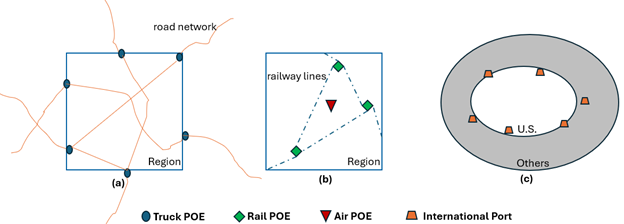Logistics Formulation#
Freight Mode and Shipment Size Choice Model#
After obtaining information on the freight shipment characteristics, such as the annual shipment demands, the involved suppliers and shippers, delivery distance, commodity attributes, other questions of interest are what type of modes should be used, and how large is the shipment size. The two decisions directly influence the freight movements in the transportation network as well as the impacts on economics and emissions. The choices of freight mode and shipment size in POLARIS determine the applied mode to ship goods and the weight of a shipment, respectively. They are modeled simultaneously as a joint decision-making problem by a closed form copula-based joint multinomial logit-multinomial logit model (MNL-MNL), which can capture the effects of common observed and unobserved factors on both choices and the interrelationship between them (Pourabdollahi et al., 2013). Both mode choice and shipment size choice are modeled by the MNL model, and a copula function is then applied to decide the interrelationship between them. There are four modes to be chosen at this stage, truck, rail, air and courier (e.g. U.S. Postal Service, United Parcel Service), and five groups of shipment size referring to the observation from a large-scale shipment survey data. The available features of shipments used in the joint model include commodity type (e.g. agricultural, chemical), commodity attributes (e.g. fragile, perishable), commodity value, shipping cost, delivery distance, and decision maker characteristics.
Important
Please refer to the the following paper for more detail:
Pourabdollahi, Z., Karimi, B., & Mohammadian, A. (2013). Joint model of freight mode and shipment size choice. Transportation Research Record, 2378(1), 84-91.
Points of Entry for Domestic and International Freight Transportation#
Points of entry (POEs) are defined as the locations where freight trade flows either enter or exit the United States and the designated modeled regions. The assignment of POEs for a freight shipment in POLARIS occurs subsequent to the freight mode choice process, and the POE is determined by the chosen mode. Consequently, the POEs in the current POLARIS-Freight framework are classified as truck POE, rail POE and air POE, as illustrated in Figures (a) and (b) below. Specifically, for domestic shipments completed by truck or courier mode, the assigned truck POE is identified as the point where the shortest path connecting the shipment’s origin and destination counties intersects the boundary of the modeled region. The Truck_Poe table in Freight database stores truck POEs for all county pairs between external county and internal county of the modeled region. Only one truck POE exists between any external and internal county pair. For rail shipments, a rail POE corresponds to a selected rail terminal within the modeled region. The selection of the rail POE is informed by the Railport table in Freight database, which lists the detailed information on the location, name and capacity of rail terminals served by Class I railroads within the region. And the assignment of a rail POE for one shipment is based on the rail network connectivity and the terminal capacity. For air shipments, the POE is selected from among popular operational airports within the modeled region based on the airport capacity constraints. The Airport table in the Freight database shows the information on the name, location, and capacity of airports. In addition to domestic POEs, international ports are also needed for shipments involving a foreign country and a U.S. modeled region . Different from above POEs, the international port is the location where a shipment enters or exits the national boundary of the United States (shown in Figure (c) below). The International_Port table in the Freight database introduces the names, counties, and geographic locations of available international ports, along with their annual import and export weights.
